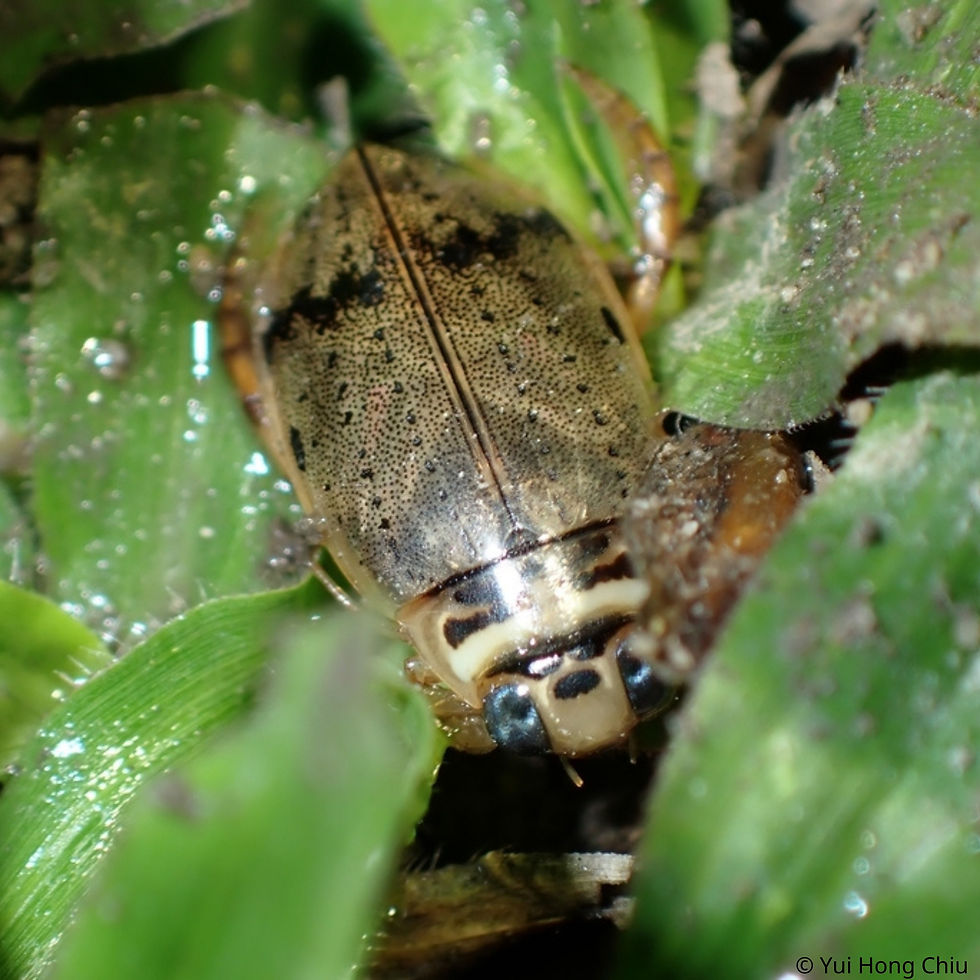Specimen Showcase | Amphibious Warriors
- Hong Kong Biodiversity Museum

- Mar 13
- 3 min read
In the 1960s and 70s, there was a common insect found under street lamps and drains of Hong Kong, and sold by many street vendors as snacks. It was then referred to as "water cockroaches," or sometimes as "tasty dragons." This species belongs to the Dytiscidae family (Coleoptera), commonly known as the diving beetles.
With over 4,000 species described worldwide, the Dytiscidae come in various sizes, ranging from tiny sesame seed-like creatures to some as large as a human thumb. They mainly inhabit freshwater environments like marshes, streams, and ponds, and are particularly fond of areas with abundant aquatic vegetation which will provide them shelters and preys.

𝘌𝘳𝘦𝘵𝘦𝘴 𝘴𝘵𝘪𝘤𝘵𝘪𝘤𝘶𝘴 (Linnaeus, 1767) is one of the species found in Hong Kong. Their length is about 1-1.5 cm, a moderate size for diving beetles, and present a yellowish-gray color, with black specks scattered throughout and a series of broken black stripes on the elytra.
Their names as diving beetles refers to their sub aquatic ecology, and we will see how well adapted they are to this unusual habitat for beetles . First, their streamlined, flattened oval-shaped bodies, reduces water resistance and increases their speed under water. They also possess elongated and robust paddle-shaped hind legs used to produce simultaneous rowing-like movements . This helps propel them through the water, resembling the action of a paddle pushing a boat. Similar to humans who need to switch oxygen tanks when diving, Dytiscidae also have a clever way of replenishing their oxygen supply. They perform a "Dragon tail” raising their tip of the abdomen above the water's surface and trapping air under their wings (subelytral cavity) to create a bubble that functions like an oxygen tank. This bubble allows them to stay submerged for extended periods, sometimes up to several minutes. In addition, while the stigmata, organs allowing air to enter into the insect body, are usually located on the side of the abdomen, in diving beetles those have migrated to the dorsal part of the body to be in direct contact with this custom made air tank.

When encountering predators and then need to leave the water, they can take off directly from the water and fly away: a submarine take-off . It was also observed that they can rotate on the water's surface before swiftly flying away but this the benefits of this behavior remains unclear.

The diving beetles are skilled predators using their sense of smell to find prey. Their long and thin antennae on their heads serve as radar-like sensors, allowing diving beetles to detect their surroundings through smell. They can capture small insects or fish, and even scavenge on carrion. They are also known as "waterway cleaners " for their role in maintaining the ecological balance of aquatic environments. Due to their outstanding hunting abilities, they are also studied for use in biological control. They demonstrate high capture rates and short hunting time to catch mosquito larvae in rice fields. They are widely distributed in Asia, Europe, Africa. So it is believed that further research and their direct use could help reduce populations of disease-carrying mosquitoes.
If you are interested in these amphibious warriors, feel free to visit the Hong Kong Biodiversity Museum to see them next time.
Text: Long Chan




Commentaires